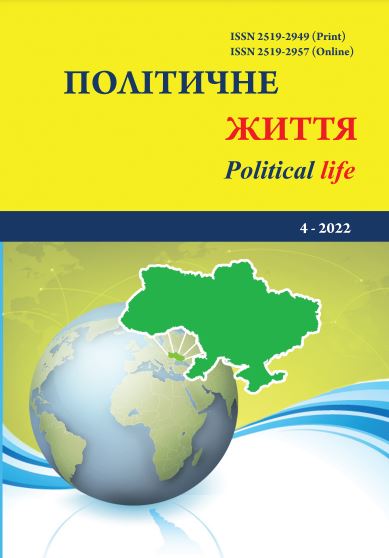(Dis)engagement in the Russo-Ukraine war
DOI:
https://doi.org/10.31558/2519-2949.2022.4.2Keywords:
Russo-Ukraine war; Russian aggression; engagement in conflict; Ukrainian national solidarity; contentious politics; PutinAbstract
The policy commentary aims to determine how the engagement of Russia and Ukraine in the Russian-Ukrainian conflict fluctuated from the beginning of the war to the annexation of part of Ukrainian lands. Drawing on Randall Collins’s analytical framework of conflict, the analysis uncovers the tendency to increase or stabilize a high level of engagement on the Ukrainian side and a decrease on the Russian side. In such a case, one might suppose that it is possible to end the war with Ukraine’s victory. Russia does not have adequate material and logistical resources. Its group solidarity, ideological polarization, emotional mobilization, and the allies’ support are insufficient to tip the tide of war in its favor. The partial mobilization of Russians and sending 300,000 soldiers to war will not change this situation because it is only one and not the essential feature of engagement.
Unlike Russia, Ukraine has no weapons of mass destruction. Simultaneously, Russia is treating nuclear weapons as a last resort. Ukraine will be significantly destroyed if Russia launches several dozen tactical nuclear missiles. It inevitably will be followed by NATO’s decision to use a parallel, though not necessarily nuclear, response, leading to the destruction of the Russian key military potential. In this case, the land forces and the Black Sea Fleet are usually mentioned as targets. The desire for retaliation and the inability to acknowledge defeat may be the main reasons for Putin’s next step and the mobilization of strategic nuclear forces. It will force the US to respond immediately with MAD doctrine, resulting in the complete annihilation of at least the Northern Hemisphere. This scenario is only possible if Putin’s decisions remain irrational and implemented.
References
Alyukov, M. (2022). Making Sense of the News in an Authoritarian Regime: Russian Television Viewers’ Reception of the Russia–Ukraine Conflict. Europe-Asia Studies, 74(3), 337–359. doi:10.1080/09668136.2021.2016633
Barrington, L. (2022). A New Look at Region, Language, Ethnicity and Civic National Identity in Ukraine. Europe-Asia Studies, 74(3), 360–381, doi:10.1080/09668136.2022.2032606
Bäcker, R., & Rak, J. (2022). Why did Putin go too far? The rationality of Vladimir Putin’s decision to begin a war with Ukraine. Society Register, 6(3), 57–72. doi:10.14746/sr.2022.6.3.04
Cancian, M. (2022). What does Russia’s ‘partial mobilization’ mean? Center for Strategic & International Analysis. URL: https://www.csis.org/analysis/what-does-russias-partial-mobilization-mean
Collins, R. (2012). C-escalation and D-escalation: A Theory of the Time-dynamics of Conflict. American Sociological Review, 77(1), 1–20. doi:10.1177/0003122411428221
Faulconbridge, G., & Liffey, K. (2022). Russia says over 200,000 drafted into army since Putin’s decree. Reuters. URL: https://www.reuters.com/world/europe/russia-says-over-200000-drafted-into-army-since-putins-decree-2022-10-04/
Hunter, R. (2022). The Ukraine Crisis: Why and What Now?. Survival, 64(1), 7–28. doi: 10.1080/00396338.2022.2032953
Kalin, S., & Michaels, D. (2022). Himars transform the battle for Ukraine – and modern warfare. The Wall Street Journal. URL: https://www.wsj.com/articles/himars-transform-battle-for-ukraine-modern-warfare-11665169716
Klain, D. (2022). Mobilization can’t save Russia’s war. Foreign Policy. URL: https://foreignpolicy.com/2022/10/04/mobilization-russia-ukraine-war/
Levada (2022). Conflict with Ukraine: September 2022. Levada.ru. URL: https://www.levada.ru/en/2022/10/07/conflict-with-ukraine-september-2022/
Palavenis, D. (2022). The Use of Emerging Disruptive Technologies by the Russian Armed Forces in the Ukrainian War. Air Land Sea Application Center Joint Base Langley-Eustis, Virginia. URL: https://www.alsa.mil/Portals/9/Documents/articles/221001_ALSA_Article_Donatas_Palavenis.pdf
Panchenkov, S. A. (2022) Letters “Z” and “V” As Symbols of a Special Military Operation on the Territory of Ukraine. Bulletin of the Khakass State University. NF Katanov 1(39), 85–90.
Putin, V. (2022). Obrashcheniye Prezidenta Rossiyskoy Federatsii. Kremlin.ru. URL: http://www.kremlin.ru/events/president/news/69390
Vajriyati, S., Basuki, L. W., Lessy, A. K., Anieda, K. I., Kuswoyo, L. C., & Meristiana, M. (2022). The Effect of the Russia-Ukraine Conflict on the Potential Use of Nuclear Weapons. Journal of Social Political Sciences, 3(3), 235–267.

